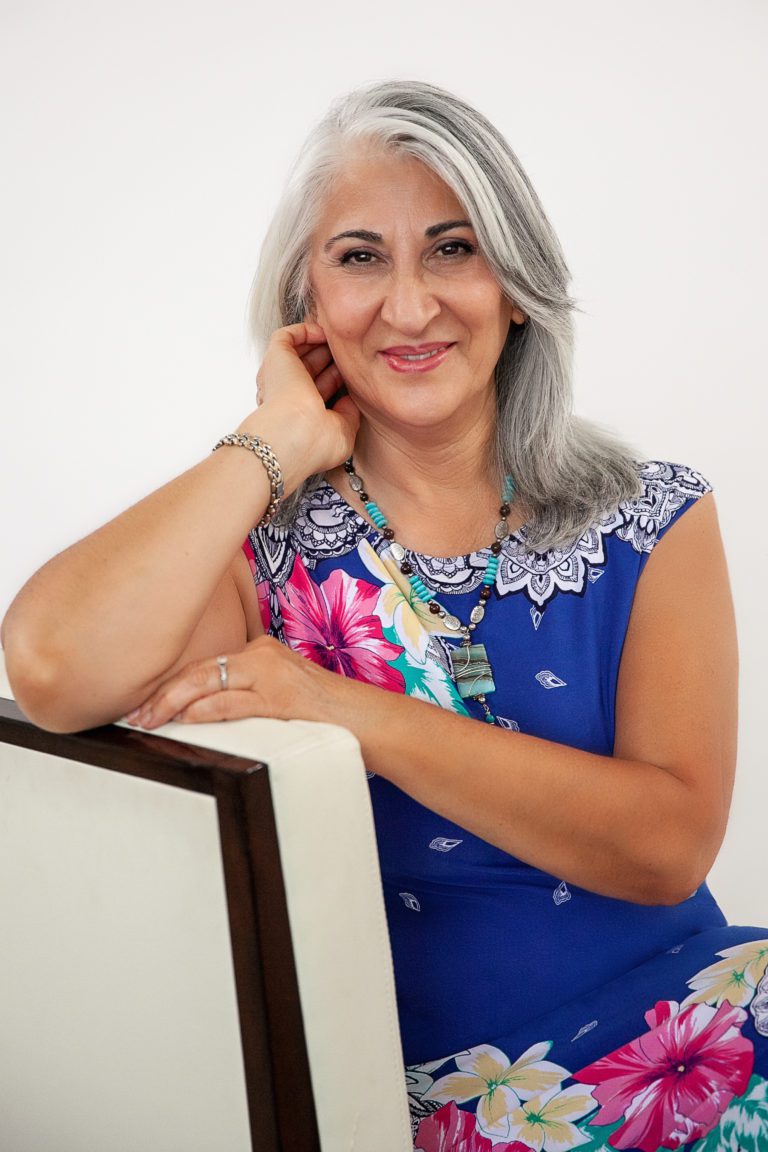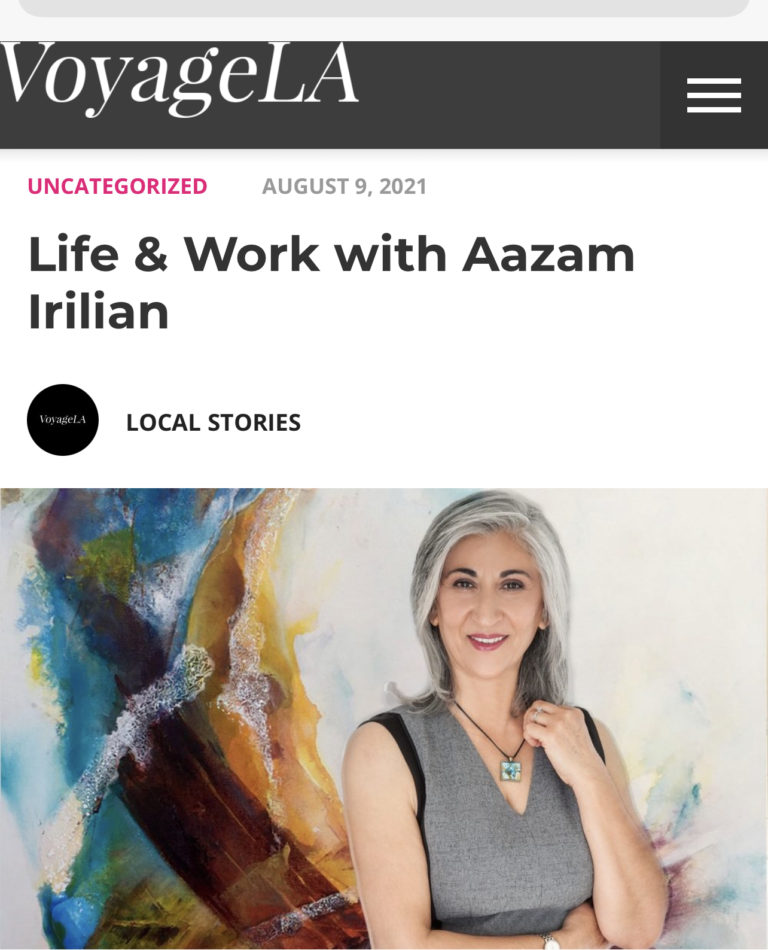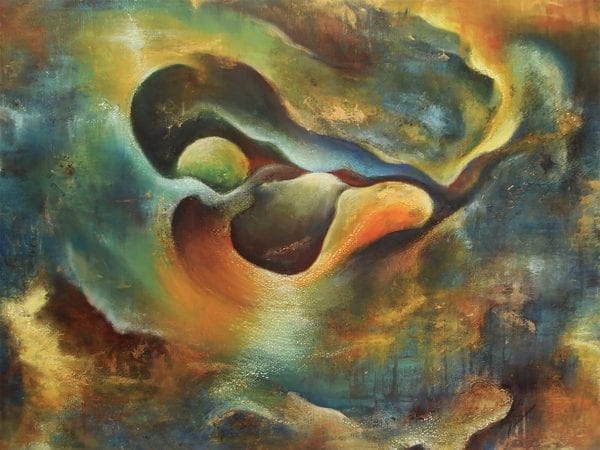Media and More
GENIE DAVIS; IMAGES PROVIDED BY THE ARTIST
At the Poway Center for Performing Arts through March 24th, artist Aazam Irilian offers a series of dynamic, vibrant worka that exudes, at the same time, a sense of Zen-like stillness and serenity. Stillness in Chaos features immersive mixed media works that are contemplative in nature and focused on the delicate beauty, precious resilience, and lush colors of the earth. The images offer succor and solace, but also serve as a fierce call to protect our planet.
Irilian says her inspiration for the exhibition began during her pandemic lockdown period. “It was during the time that the whole world was in turmoil. In addition to the outside world, my personal life was also changing rapidly.” After 43 years of marriage, Irilian’s husband was diagnosed with dementia which progressed rapidly. “Between the outside world and what was happening at home, everything seemed to be in chaos anywhere I looked,” she relates.
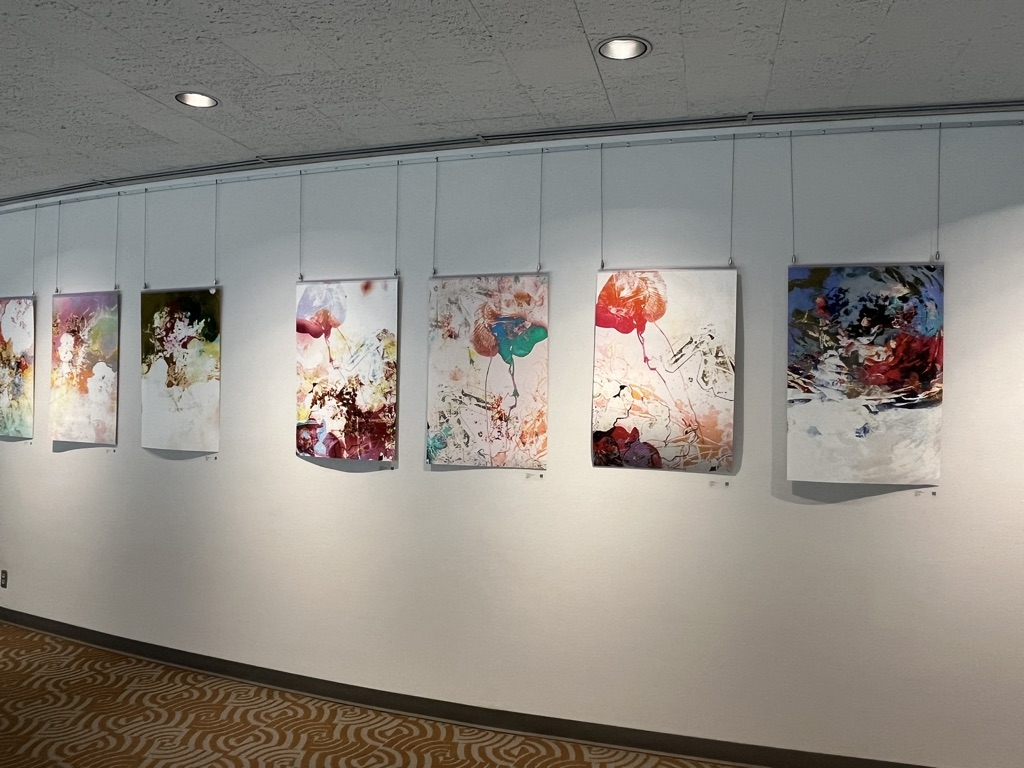
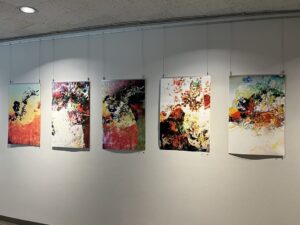

Along with this sense of purpose and meaning in her palette, Irilian notes that her process would also return a sense of calm, and to memories of her experiences in nature. It was the calm engendered by her process that shaped the exhibition title.
The artist considers her work to be “multi-perspective…meaning that the viewer needs to bring their own experience into each piece and decide what it is they are looking at.” Each work makes a fresh kind of landscape, in which the viewer alone determines what they are seeing and their point of view, including aspects such as whether they are looking into, down, or up at a given landscape. Viewers are likewise encouraged to determine if a particular image reminds them of a location or experience.
“Take your time,” Irilian says, “really see how a piece makes you feel, what or why you resonate with it—experience being in the moment and letting go of the craziness of your day.” The richness of Irilian’s palette encourages this type of contemplation. Of it, she says “I believe life is beautiful and filled with joy, regardless all its challenges.”
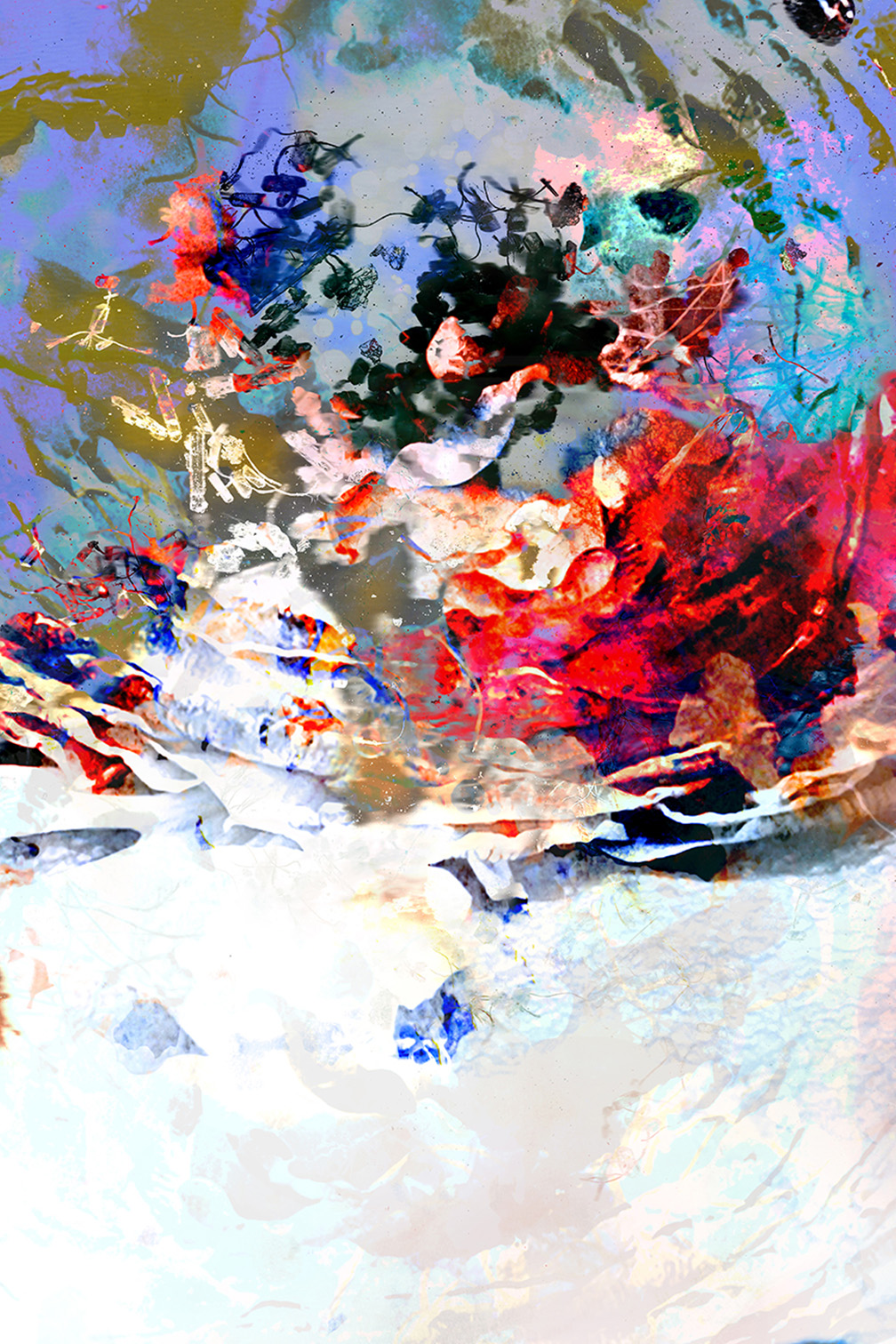
Combining both original paintings and limited-edition digital assemblages that mirror the artist’s painting style, the exhibition’s open and light-filled space at the Performing Arts Center reflects the show’s creative energy and overall sense of poetry. “Regardless of the medium or the type of art, [my] process is visualizing this energy as waves of light and color, dancing and moving through me, flowing through my hands, and landing onto the canvas or the surface I am working on. I create in a state of mind that I want my viewers to feel when looking at my art.”
While the exhibition blissfully utilizes Irilian’s signature fluid, flowing style, some pieces indicate a transition for the artist in the use of sharper, more angular strokes that fill a full canvas.
Overall, the show is lush in its abundance, as flowing as water or wind; it is lustrous work that shimmers with purpose and passion.
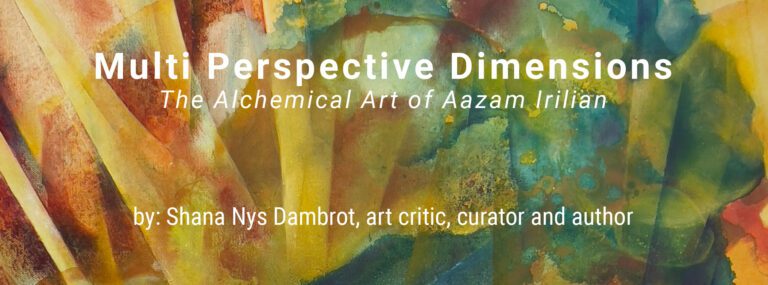
Nothing in life is to be feared, it is only to be understood. Now is the time to understand more, so that we may fear less. —Marie Curie
Shana Nys Dambrot, Art critic, curator, author
In the beginning, it was just about experimentation. Aazam Irilian was in her painting studio, chasing a sense of mystery. From the particulate, atomic “Flow” and evolving into the molten, prismatic “New World” series, she practiced her penchant for fluid, multi-perspectival dimensions, deepening colors, and aspects of simultaneous perspectives. To further energize each canvas—to honor a spark in her work that was already reaching toward something beyond itself—she turned to alchemy.
Salt is life itself, but it is not alive. Its crystals are hard and delicate and ever-changing. It’s a humble material with Biblical echoes, and it has a role in the present ecological discourse. “I loved the texture that I was getting from the salt and the way it was affecting the movements of the paint,” she says. “I’m inspired to bridge the gap between art and science. But lately I’m moving away from using salt on canvas, because I want to make sure that when a piece leaves the studio, I don’t have to worry about it continuing to…evolve on its own.”
Instead, she manifested a different kind of evolution—one that was less focused on the nature of the medium and more engaged with the medium’s power to open portals to other, higher light-filled dimensions. From a rich palette of hot seasons and gemstone flames, during the tumultuous, interior times of 2020, she turned to the resonant refuge of blue.
“Indigo Dreaming” is a painting series full of stories—about herself, her life, her loved ones, the world in its chaos. Her paintings from this time have multiple layers like Aboriginal art whose meanings reveal themselves with time and age. At first glance abstract, infused in its flowing choreography of color and physics are Aazam’s responses to the fear, othering, and violence in the world—communicating in their harmony of swirls the essential oneness of humanity across its differences.
“The idea was to begin with the indigo and its variations, then to introduce one additional color and to allow and observe how they flow into each other in a way that creates new patterns, new colors. I see this as a metaphor for the free interaction of people,” she says. “My vision with this series was—and remains—that we will be able to see, love, and protect this beautiful human community.”
As much as her previous work was about embracing the world, in Aazam’s newer pieces, from the ongoing “Beyond the Veil” series, she takes on the idea of the multiverse—the increasingly popular and proven idea that there are worlds that are not visible to our eyes, and yet exist. “I’ve always been interested in the world beyond,” Aazam says, and in her imagining of it, the other realm is overflowing with light. “You can call it divine light. You can call it spirit, whatever. But there’s a whole universe of pure light that we can experience if we open ourselves.” In that context, she sees these paintings as rifts in the fabric of time and space, mysterious places where the light can come through.
It’s so appealing, even satisfying, to stray into a conversation about the web of optics, transference, quantum physics, observational effects, Doctor Who, Ursula K. LeGuin, and even the recent artist-built Marvel multiverses. An unexpected vector, in some ways, in the context of a conversation about Abstract Expressionism, but the one to follow is the question about how a painter makes that fine art idiom into something personal, multidimensional, spiritual, and modern.
And Aazam makes digital work, as well; perhaps counterintuitively, it’s initially based on the salt crystals. She grows them in her laboratory—er, her studio—introducing organic materials and found objects for the salt to grow on. She photographs the results and layers them to create digital assemblages—new hybrids of the organic and technological, metaphors and metonymies that contain their own opposites at the same time, hinting at something that could go on forever.
Aazam has ancestors in art history—painters like Helen Frankenthaler who investigated flow, flatness, and saturation as an extension of both her body and her consciousness; or Anselm Kiefer and how he likes to bury his canvases in the earth to see what nature has to contribute. Petra Cortright, who uses digital interventions into conventional painting to expose the true mechanics of invention. Visionary artists, especially pioneers like Agnes Pelton and Emil Bisttram who sought to give fixed form to invisible forces and create prompts for interior questing. Georgia O’Keeffe, with her love of the fractal matrix behind all the world, and her feminized ideation of that energy…
To these conversations, Aazam Irilian brings her own perspective, sense of materials, unbounded curiosity, and a desire for transcendence—creating and solving life’s small mysteries one canvas at a time.
—Shana Nys Dambrot
Los Angeles 2024

Artist Aazam Irilian Offers a Stunning Look at Memory and Loss
Genie Davis; photos provided by the artist and by LA Art Documents
At the Main Theater in Santa Clarita last month, artist Aazam Irilian presented a sensitive, impactful, and beautiful exploration of memory – and how fragile and meaningful our memories are in human life. Preserved Memories, her exhibition on the impact and progression of dementia, packed a powerful and poignant punch.
Consisting of five different major sections, Irilian’s work depicted personal and moving stories through a varied and immersive mix of mediums including sculptural assemblages and recorded stories. The exhibition also allowed space for visitors to write their own stories.
In the exhibition’s “Transitional Bodies,” a series of delicately rendered graphite drawings of brain cells, neurons and more are intricately revealed in stylized bodies on panels of white fabric.
A series of “Shredded Mind Panels,” created on canvas panels in richly colored red darkening to shades of brick, are used to depict the loss of memory. Holes in the panels represent the losses caused by dementia, as the canvases gradually turn into trailing, shredded surfaces.
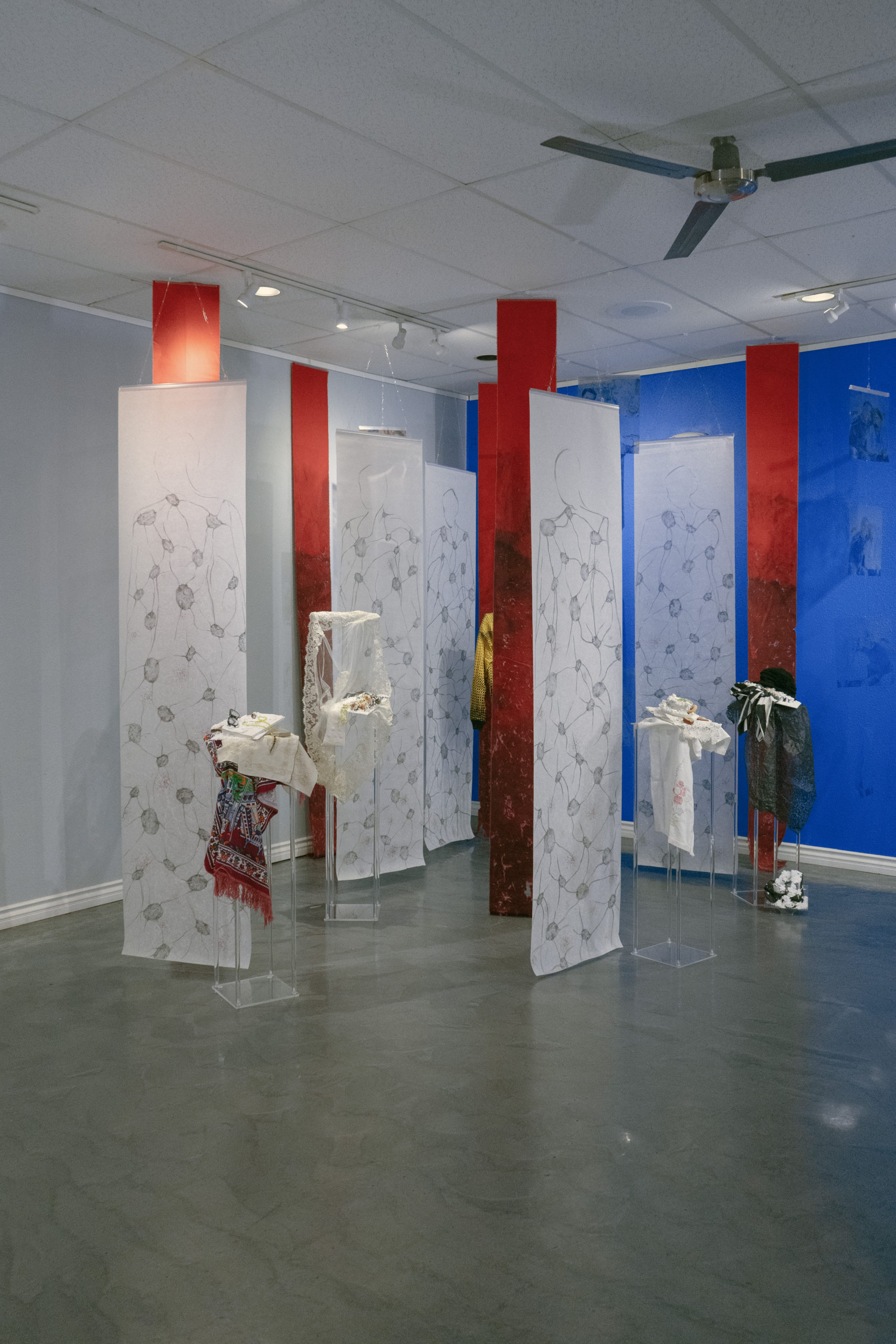
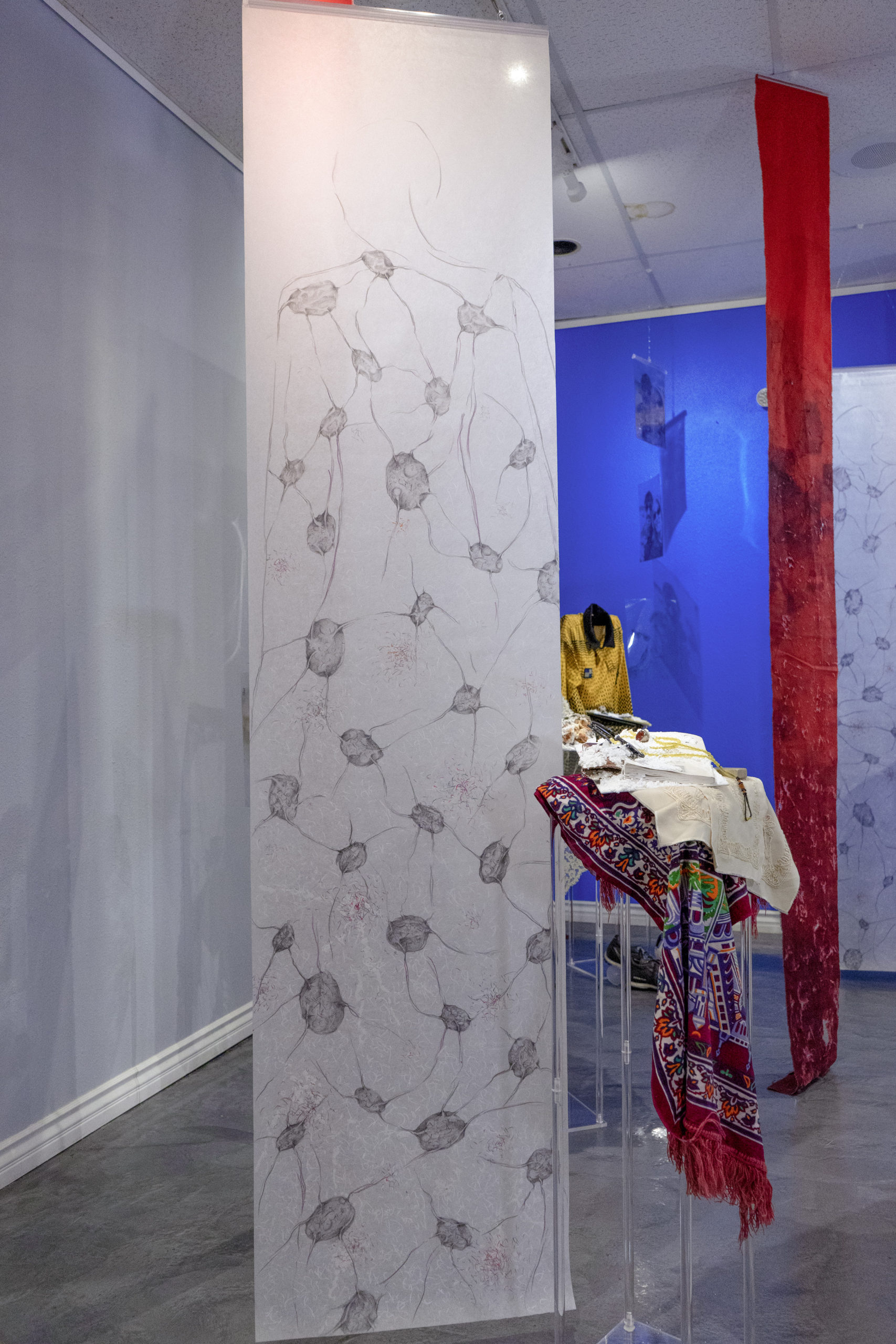
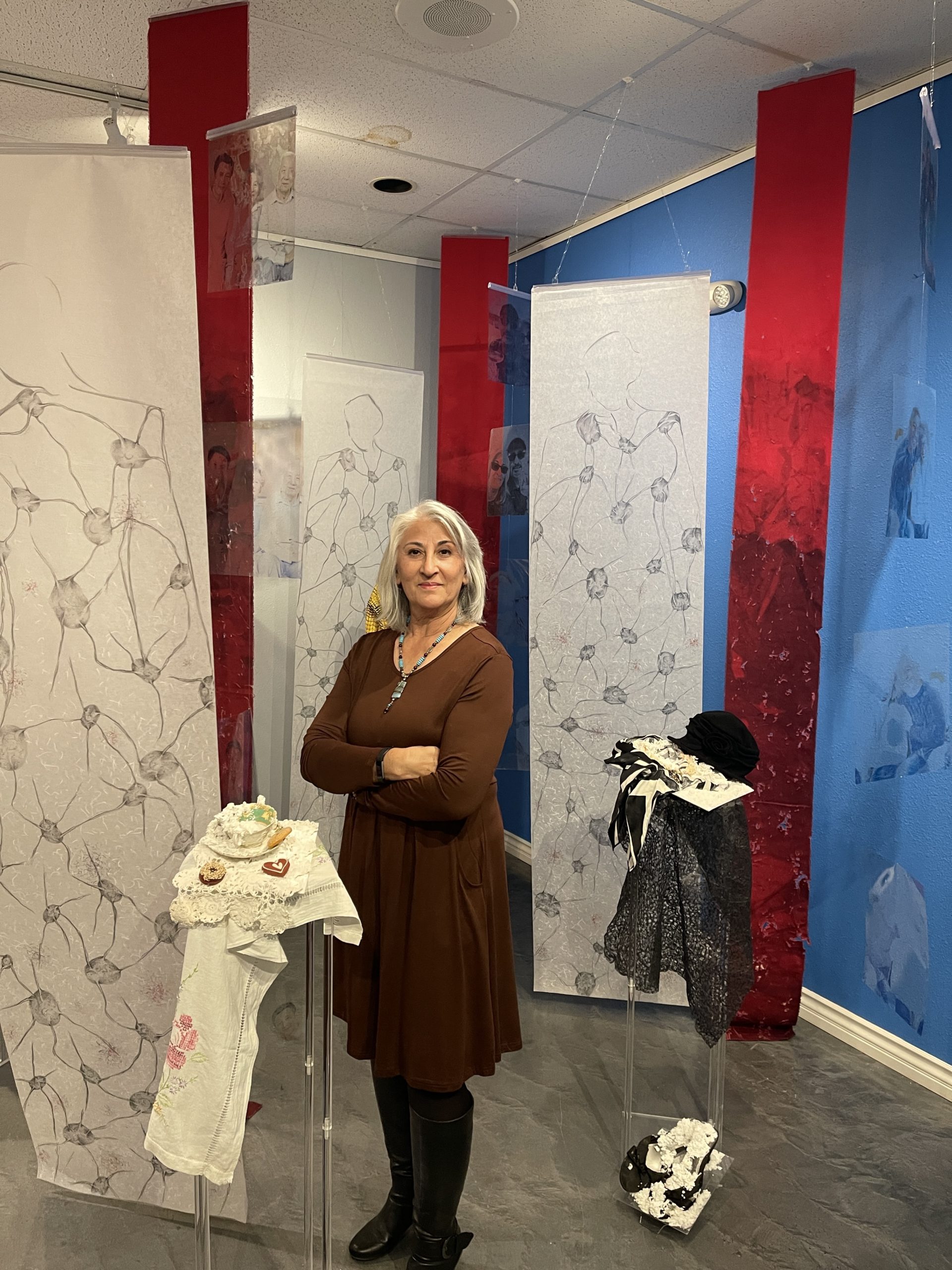
Perhaps the most compelling element of the exhibition is the titular “Preserved Memories,” a series of sculptural assemblages created out of personal memorabilia and preserved in salt. Stories that relate to the sculptures are a part of the recorded messages and memories section of the show. The sculptures themselves are haunting and nuanced, puzzle pieces of a life, the meaning of each piece transitory.
The haunting sculptural assemblages are, Irilian says, the focal points of the exhibition, which is not surprising to hear given the intensity and complexity of these works. Each represents an individual’s stories. According to the artist, “The soccer player piece is made of my husband’s soccer gears as referee. He was an engineer and played soccer most of his life. He also had coached and was a referee for the last 20 plus years.”
Using a variety of salts and mineral solutions as a part of her creative process, Irilian created a layered depth to her sculptures which arose from painted work. “The textures you see on my paintings are results of interaction of mineral solutions with paint. With each series, I aim to push the use of mineral solutions to a different level. With this installation, I pushed myself to see how I can grow and use these crystals off the canvas, onto the objects.” She notes that “Salt has been used as a preserving agent over the ages. The point here was to use the salt as the metaphor—preserving memories that are fading away.”

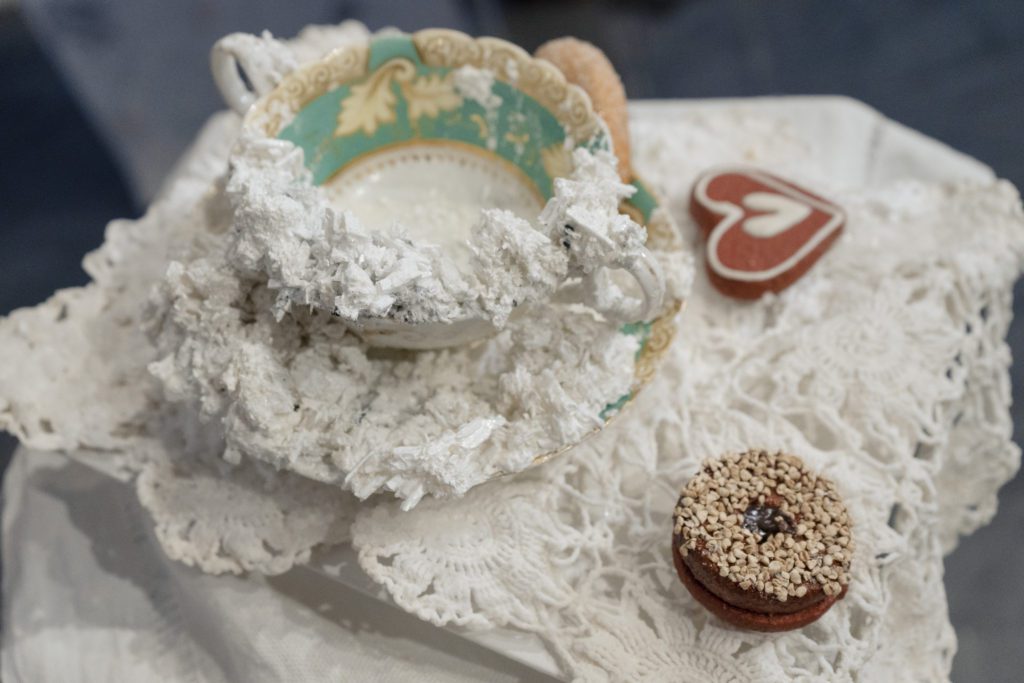
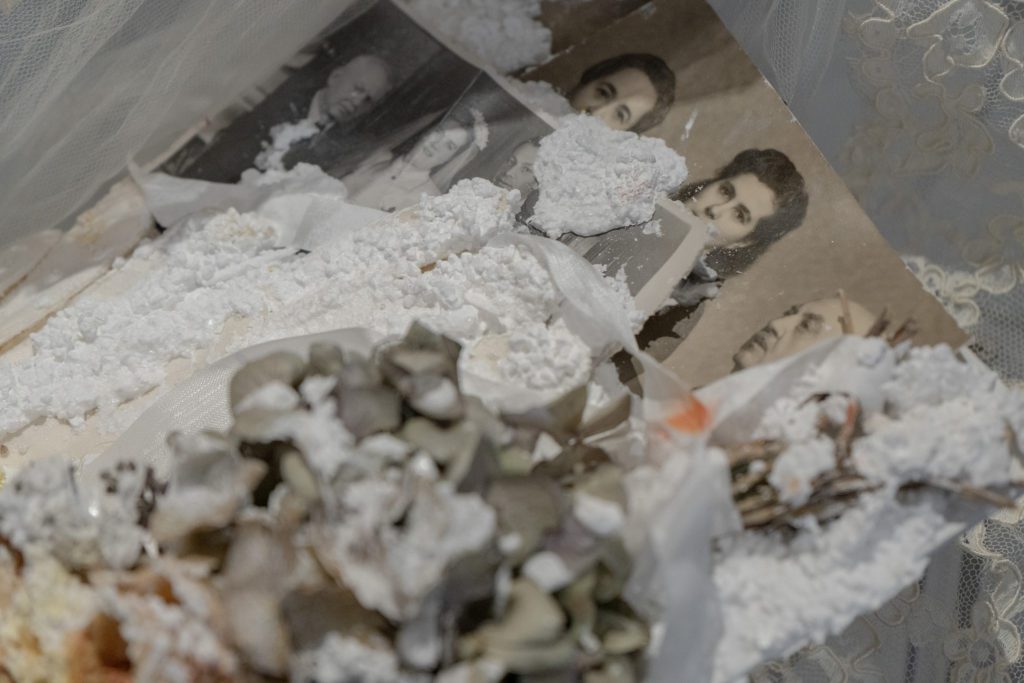
And in the series “Fading Family Portraits,” photographs printed on Duralar clear paper depict families of different cultural backgrounds who have suffered from dementia, revealing that the disease is not discriminatory and can strike any family, regardless of heritage. In a succession of photos, each face appears less and less clear, with ghostlike faces gradually fading away altogether, emblematic of how recognizability fades for a person with Alzheimer’s.
Each of these exhibition sections are evocative and sensorial, creating in the viewer a sensation of loss and legacy, of both the joy and pain of remembering.
Irilian does not approach her subject uninformed. She was both wife and caregiver to a husband who suffered from dementia. Dealing with both her own and his sense of loss keenly, her work movingly stresses that despite fading memory and a loss of identity itself, the afflicted person will not fade from our own memories and hearts.
The exhibition is important not just to Irilian personally but to so many, with the strong possibility that by the year 2050, those 65 and older suffering from Alzheimer’s are estimated to reach the daunting number of 12.7 million affected individuals.
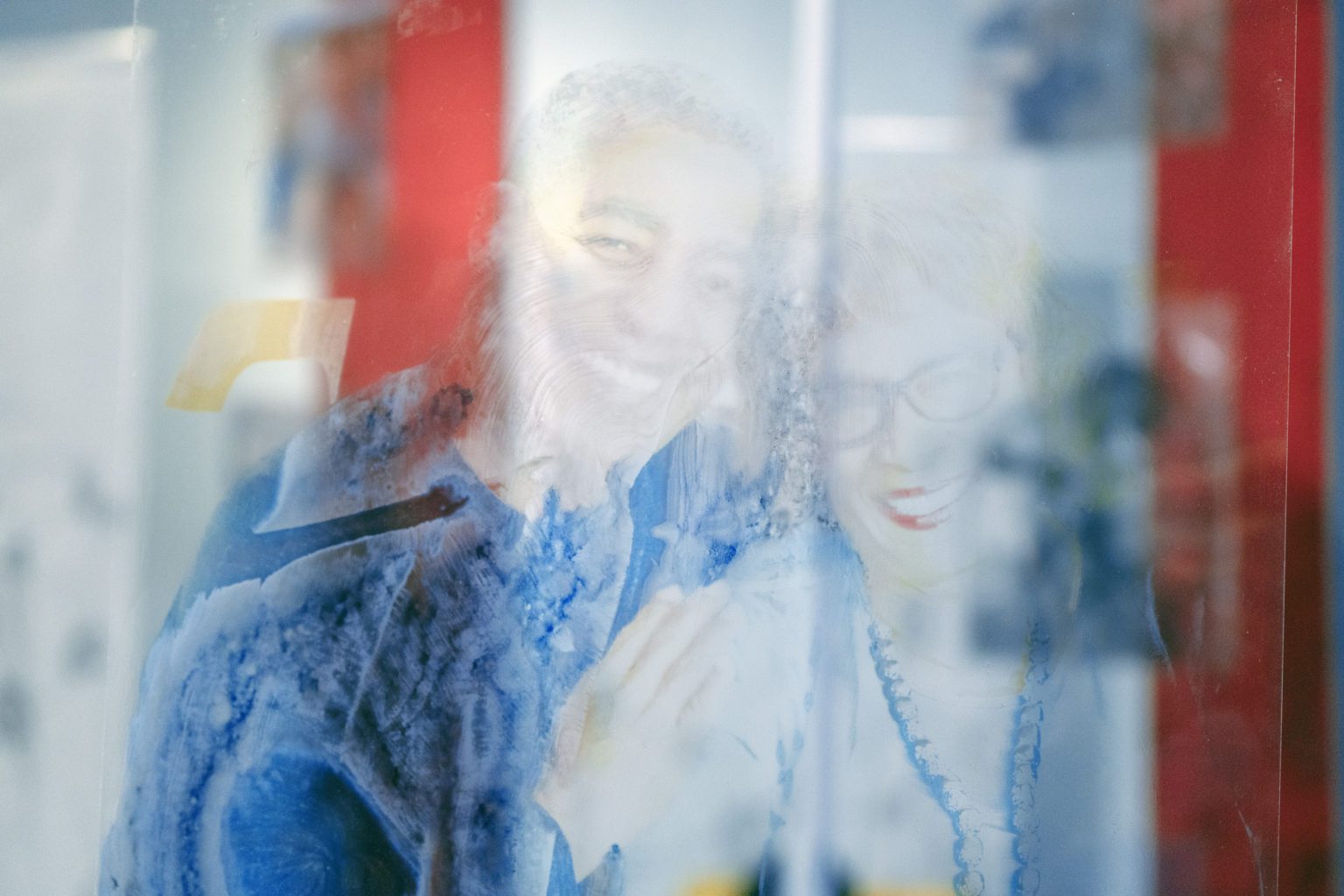

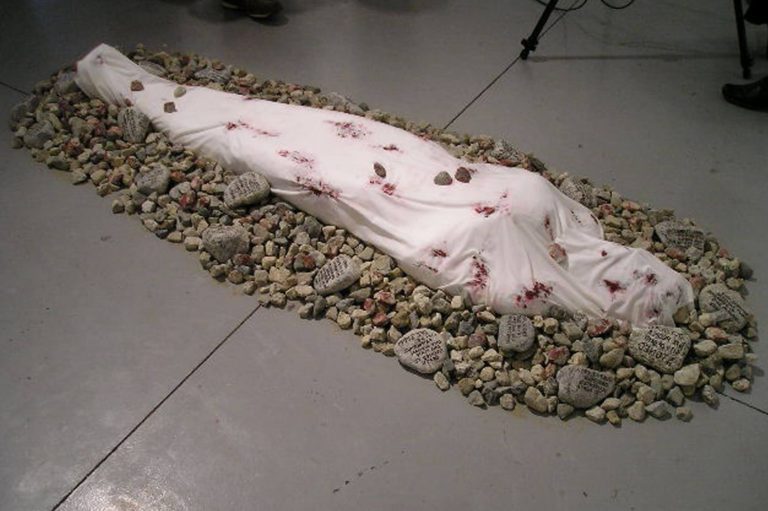
This is not Irilian’s first installation work. The artist created the exhibition “Dare to be a Woman” at CSUN in 2004, and “Stoning” in 2005. Both employed a variety of mediums in their representation of violence against women in Iran. In “Stoning,” part of a 5-woman exhibition, she used a plaster cast of her daughter’s body. In short, the artist is no stranger to using the personal to represent a more universal situation.
Preserved Memories very much expands on these and other past work of the artist, who terms herself “a curious person…[who] wants to learn as much as possible, and that includes learning about how things are made and work. I feel installation is just another way, another tool in my bag of tricks that I can use to bring an idea into form.” Irilian never prefers one medium over another, she says. “It is about what medium can help me to bring in to form the idea or the concept.”
She strives to tell a story through her art, as well as to “create an experience or evoke an emotion. I want the viewer to bring her/his experience into each piece and find or form his own story viewing the work.” With Preserved Memories, she relates that most of all, she wanted to bring attention to the devastating disease, and impress a human face upon it, while “communicating the fact that the person we love is still there.”
View Original article
Aazam Irilian’s Stories of Dementia
By: Dr. Betty Ann Brown, art historian, critic and curator
I tell a story, and therefore I exist.
Shekhar Kapur
California artist Aazam Irilian has always dealt with time and memory in her artworks. Over the last several years, she cared for her beloved husband as he suffered from dementia. When he went into board and care, she transitioned from lyrical abstract paintings to installation work honoring people devastated by dementia. Her “Preserved Memories” is composed of three series of artworks. One group is elegant drawings of cells and neurons on lightweight Pellon fabric. These banner-like images serve as “interior portraits” of dementia patients. The second component is comprised of photographs printed on Duralar. The images at the top are clear, but as they are reprinted down the banner, they gradually fade–much like ageing memories. The two kinds of banners hang near assemblage sculptures of memory-laden objects that refer to the stories with which people identified themselves. The mnemonic objects are selected and arranged on plexiglass pedestals, then adorned with splashes of salt crystals representing the waves of memory, identity, and loss. (The artist has used salt crystals to great effect on the surfaces of some of her abstract paintings.) Irilian’s compilation of memorabilia recalls the religious tradition of reliquaries, precious containers that held sacred relics and were intended to sustain the memory of past people and events. (Christian relics, for example, included the physical remains of saints, including bones, as well as pieces of clothing and other objects associated with the religious figures. Relics–especially those associated with the prophet Muhammad–were venerated in Islam as well.)
In “Preserved Memories,” Irilian’s husband, who loved soccer, is portrayed by a referee’s shirt and a cluster of team badges. An elderly woman, who loved antique shopping with her daughter, is recalled by a vintage cup and saucer, carefully positioned atop a crocheted doily. Another woman is portrayed by a white lace wedding veil: obviously, her marriage was a cherished remembrance. And one man is represented by thick-rimmed glasses, green amber prayer beads, and a ring of brown amber set in silver: a Muslim, he spent many hours prayerfully reading the Koran.
The third component of the “Preserved Memories” installation is a series of recordings about people with dementia. Irilian taped her friends, family, and other acquaintances as they spoke about their experiences with loved ones who had dementia. Their words form an auditory counterpoint to the visual artworks. As we gaze at one pedestal of memorabilia or one banner of cellular traces, the spoken stories add a further dimension to the aesthetic environment.
Memory loss is a disturbing part of the ageing process. One out of nine Americans over the age of 70 has dementia or Alzheimers, but the general public has very little awareness of these pervasive conditions. People with dementia gradually lose memories…which means they lose the stories they have always told themselves about who they are. But as actress Carey Mulligan reminds us, “Those with dementia are still people and they still have stories and they still have character and they are all individuals and they are all unique. And they just need to be interacted with on a human level.” Aazam Irilian’s “Preserved Memories” installation presents the stories of individuals with dementia, giving them voices through the presentation of the objects and images that meant so much to them.
Painting the Flow: The Glorious Art of Aazam Irilian
by Betty Ann Brown, Art Historian, Critic & Curator. l July 2021
If you are quiet enough, you will hear the flow of the universe. You will feel its rhythm. Go with this flow. Happiness lies ahead. ~The Buddha
Aazam Irilian allows paint to flow across her canvases in elegant chromatic fields that suggest water, waves, and cosmic nebula. Her paintings are abstract, but they inspire viewers to engage in Pareidolia, the psychological tendency to see meaningful shapes in ambiguous visual patterns. (Do you see the horse in that cloud? Doesn’t that coastline remind you of an old man’s profile?)
The paintings bear witness to the artist’s process: her immersion in what Hungarian-American psychologist Mihaly Csikszentmihalyi calls the flow. Fascinated by people–especially artists–who became so involved in an activity that nothing else seemed to matter, Csikszentmihalyi analyzed the flow experience as an altered state based on total collaboration with what shows up. For Irilian, “what shows up” is the nature of paint, its viscosity, texture, and malleability. She pours watery pigment over the canvas, allowing it to flow into pictorial existence. Then she layers the paint with salt and other minerals dissolved in liquid and allowed to dry in lacey chemical patterns. Both of her materials–the paint and the salts–flow spatially. And Irilian’s mindful concentration on her process evokes the flow experience.
Irilian’s Indigo Dreaming series presents a group of canvases crossed by an astonishing range of blues: azure, cobalt, sapphire, and ultramarine. Blue has a long historical significance: the Ancient Sumerians and their Egyptian contemporaries used lapis lazuli imported from far-off Afghanistan to symbolize birth, rebirth, water and the heavens. All of these references are poetically evoked by Irilian’s elegant canvases.
Cenote Medicine has a darker palette, with blue framed by mossy green and splashes of blood red. Inspired by her experience of the sacred cenote in the Ancient Maya site of Chichen Itza (in Mexico’s Yucatan Peninsula), the artist allowed her flowing paint to build geological references. Hills, caves, and sparkling rivers of gold swirl across the compositions, encrusted by foaming splashes of white mineral salts.
Irilian’s most recent series is entitled Beyond the Veil. The sharp, angular lines contrast markedly with her earlier curvilinear preferences. Some are blackened, like burnt tree limbs. Others are amber or coral, introducing new tones to the oeuvre. The artist has written about the experience of creating these works:
Veils of color,
Appear in layers of shimmering lights,
Flashes with reflective edges.
Stepping beyond the veils,
I find myself,
In worlds, intriguing and vast,
Each more astonishing than the next…
This quest for “intriguing and vast” worlds, “each more astonishing than the next” could be used to characterize Irilian’s flow process in all of her painting series. And we as viewers are invited to enjoy the aesthetic pleasures of exploring such astonishing worlds with the art.
Hi Aazam, thanks for joining us today. We’d love for you to start by introducing yourself.
I was the girl at school who everyone would come to and ask to draw something for them or were in awe of her science notebook illustrations. Being an artist was not on my radar until my ninth-grade art teacher submitted one of my pen and ink drawings to the district’s art competition. I became interested to learning about pursuing art when my piece moved up to the all-city school art exhibition. That was the beginning of my art journey.
From then on, I got my hands on any art supplies I could get and started learning about different mediums. My parents in their own way nurtured my artistic pursuits, supporting and providing what was necessary for me to learn more. They were both creatives as well. My mom with creating needlework designs and cooking, and dad with rough sketches of his small building projects he would go on to develop.
Today we’d like to introduce you to Aazam Irilian.
Hi Aazam, thanks for joining us today. We’d love for you to start by introducing yourself.
I was the girl at school who everyone would come to and ask to draw something for them or were in awe of her science notebook illustrations. Being an artist was not on my radar until my ninth-grade art teacher submitted one of my pen and ink drawings to the district’s art competition. I became interested to learning about pursuing art when my piece moved up to the all-city school art exhibition. That was the beginning of my art journey.
From then on, I got my hands on any art supplies I could get and started learning about different mediums. My parents in their own way nurtured my artistic pursuits, supporting and providing what was necessary for me to learn more. They were both creatives as well. My mom with creating needlework designs and cooking, and dad with rough sketches of his small building projects he would go on to develop.
I never had any official training in the arts until I attended college. In addition to the fine arts, I studied interior design, architectural drawings/renderings, ceramics and sculpture. I’ve always loved learning and wanting to know about how things work. It’s something that I inherited from my parents, especially my dad. It is because of this “wanting to know” that I love experimenting with different material today as part of my art-making process. It seems that I’m always working on several projects at a time—somehow related to each other—pushing the material even more to see what happens. Sometimes the result is successful and sometimes not –however, it’s always a learning that leads to the next breakthrough.
My art career would not be complete without mentioning my …
Meet Next Level Artist Aazam Irilian
by Sergio Gomez 2020
Do you have a studio routine, strategy or ritual that helps you get in the creative zone?
I spend a few hours (almost) everyday in my home studio. I begin each day by:
Reading or listening to inspirational programs/recordings
15-20 minutes of meditation
Sitting with the new canvas/work in progress to be directed on the next step
Cleansing process by burning sage in the studio
My painting process depends on which phase the painting is at—I paint by allowing paints to flow on the canvas and have to allow drying time between each layer.
How has the pandemic affected your art practice?
For the first few months, I was very focused, worked and completed a series of fifteen paintings. Lately, as I’m looking into creating a new body of work,
In this therapeutic 7-day course, accomplished artist and art educator Aazam Irilian provides a variety of artistic techniques to help you tap into your natural creativity through personal stories, reflections, and authentic artistic expressions about you and your life. In this course, Aazam combines step-by-step instructions in art, imagery, and creative writing as tools to explore your inner strengths and the lessons you have gained from your experiences. Every lesson is a practical and powerful way to encourage mental and emotional clarity for deeper understanding of your life’s journey. That journey does not end with the present but extends into the future as you devise your plans and take action toward achieving a future that only you can imagine. By the end of the course, you will compile all the work you’ve done during the course and create your very own beautiful and personal book about your life to keep.
Who should take this course:
- Anyone looking for a unique, holistic approach to healing from a past emotional wound or trauma.
- Those who would like to develop more self-expression and creativity in their lives.
- Individuals interested in art therapy, and fostering self-awareness and personal growth.
- Everyone interested in learning from and releasing a past experience and becoming more present.
- Those who want to develop a greater capacity for forgiveness and compassion for themselves and others.
Learning or revisiting the basics of self-reflection and creative expression for personal healing can help you to understand your past and envision your future. Begin your journey now!
Aazam Irilian, Master of Healing Arts
Martha Michael l AUGUST 17, 2018
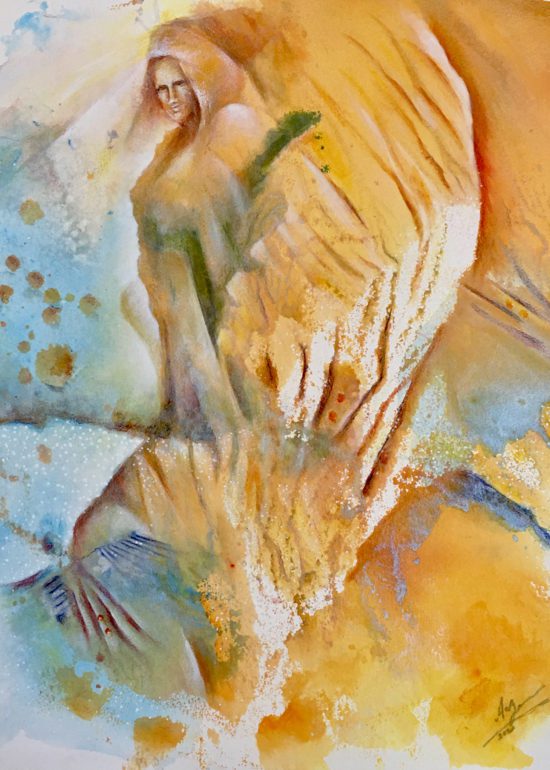
Spending time with Aazam Irilian is like being in a master class. You’re in the presence of both a teacher and a guide, sometimes unaware that she’s taken you on the road to self-discovery.
She has a master’s degree in education with a teaching credential in visual arts, and what’s perhaps most evident about her is her two-pronged tendencies: creating and teaching.
“I’m an artist in my core,” Irilian says. “From the time I can remember, I’ve been creating in a variety of mediums and modalities. It is literally my passion – one that, if not engaged in, I feel the empty space in my heart.”
Learning from Aazam is not just about artwork – it’s about soul work. Among her talents, she paints “Soul Portraits,” which are commissioned paintings she creates for and about a client after consultation and meditation.
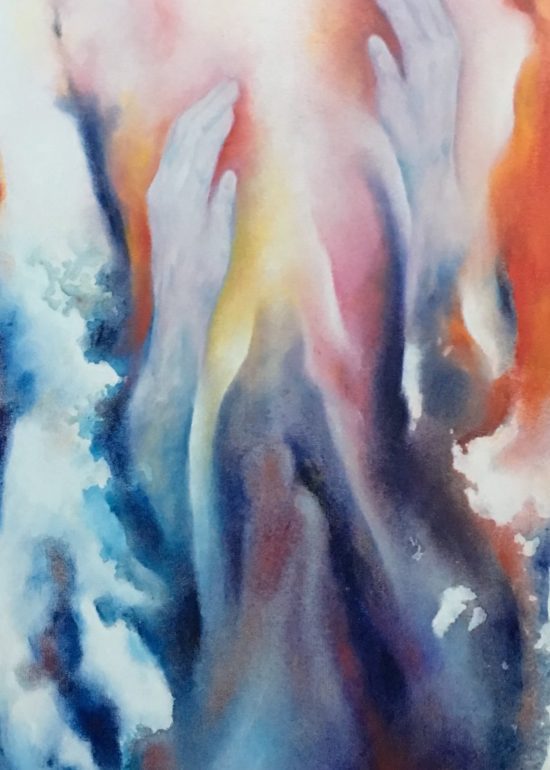
A local program helps domestic violence survivors develop ways to mend their souls.The day Aazam Irilian realised she stopped smiling was the day she decided to change her world – she just didn’t know how yet. Her mother had recently succumbed to a painful battle with cancer, and her job as an arts educator was taking up so much of her energy that she had little left for anything else. As she reached a level of professional success that should have brought her great joy, Aazam instead felt drained from the journey and disappointed with the lack of passion and challenge left in her career’s future. She wasn’t quite clinically depressed, but she hadn’t noticed when the smiles stopped either. She missed the joy of a fulfilling life, and she missed the art that used to help her express that life.
“Art and creating are my passions, something that feeds my soul,” Aazam said, “but I didn’t have time to engage in that anymore. Nothing was enough or satisfying. When you get to that place, it impacts your point of view of yourself, and I became my own worst enemy.”
Soon a new position fell in her lap – like the job was written just for her. But she was terrified.
“I was paralyzed by the fear of moving because I was in a safe place, even though it was so stressful,” she said.
Aazam saw the opportunity as a reminder that the universe has its own plan, and she jumped on her dream job. She quickly knew she had made the right choice – the choice to believe in herself, to choose herself. Even better, she had time for art again.
“Slowly, I started using the creative process to heal myself,” she said. “I wasn’t creating for the purpose of exhibiting because all I wanted was to express myself, my emotions.”
She grew artistically and professionally. Her family and friends caught notice. And soon, she felt fulfilled and whole again.


